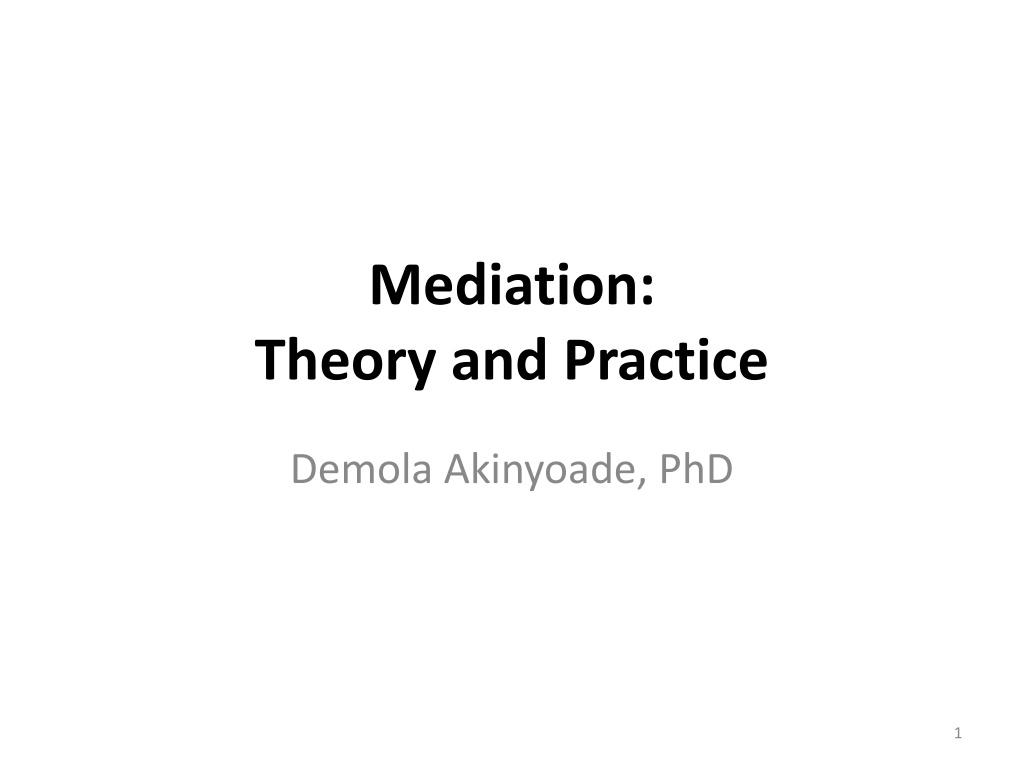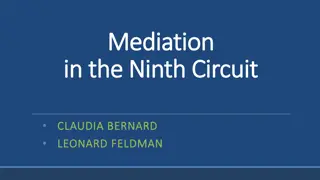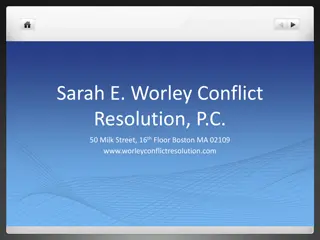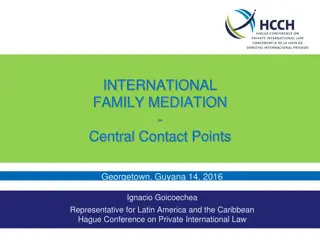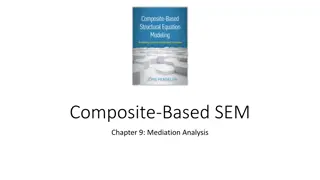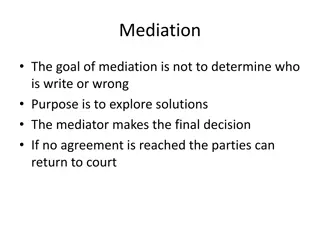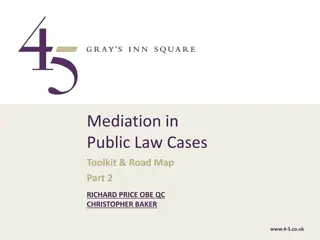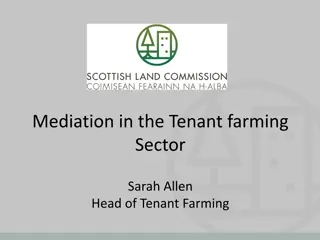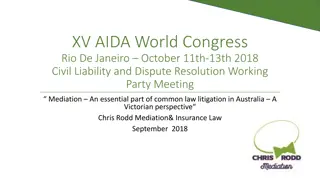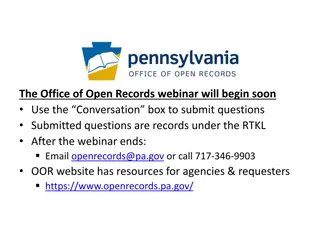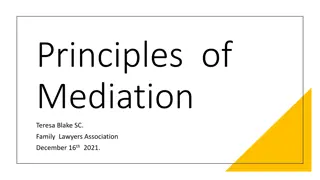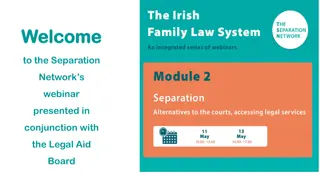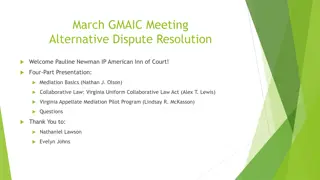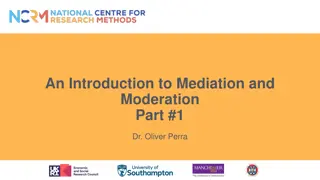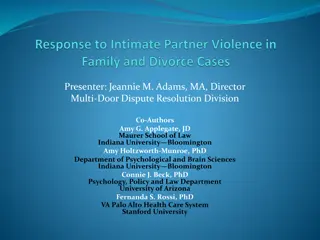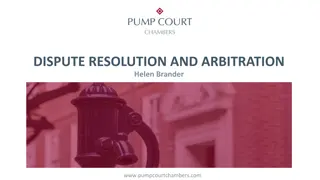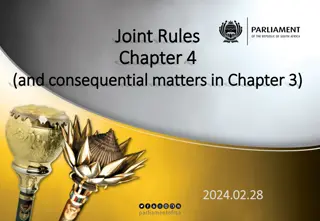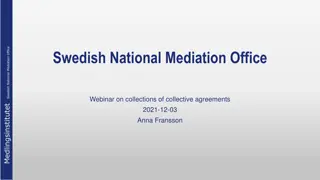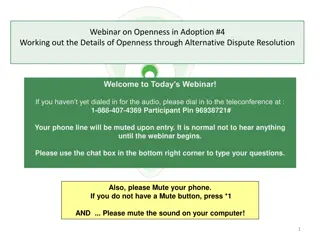Understanding Mediation: Theory and Practice by Dr. Demola Akinyoade
Alternative Dispute Resolution (ADR) offers a spectrum of methods, with mediation being a voluntary, non-binding process where a neutral third-party facilitates dispute resolution. Contrastingly, litigation has drawbacks such as delays and costs, while ADR has advantages like swift resolutions and improved relationships.
Download Presentation

Please find below an Image/Link to download the presentation.
The content on the website is provided AS IS for your information and personal use only. It may not be sold, licensed, or shared on other websites without obtaining consent from the author. Download presentation by click this link. If you encounter any issues during the download, it is possible that the publisher has removed the file from their server.
E N D
Presentation Transcript
Mediation: Theory and Practice Demola Akinyoade, PhD 1
Overview Alternative Dispute Resolution (ADR) Spectrum Mediation Described The Mediation Process Principles of Mediation Mediator s Role Kinds of Mediation 2
Alternative (Appropriate) Dispute Resolution (ADR) Spectrum All forms of dispute resolution other than court-based adjudication/litigation Negotiation Mediation Arbitration Conciliation Special Envoy Judicial Appraisal Adjudication Expert Determination Ombudsman Med-Arb Executive Tribunal Neutral Fact-finder 3
Minuses of litigation Delay Prohibitive costs Bogged-down justice system Case congestion Restrictive single option Unsatisfactory determination of cases Ruined relationships Reduction in foreign investment 4
Pluses of ADR Sustenance understanding Restoration of pre-dispute relationships Public satisfaction with the Justice system Creation of resolutions suited to parties needs Increase in compliance with resolutions Increase in involvement in the Peace Process of mutual Access to justice for all Reduction in case dockets of Judges Speedy resolution of disputes Reduction in parties expenses and time Harmonious coexistence Accommodation and tolerance voluntary 5
Negotiation Litigation MEDIATION Med/Arb Arbitration ALTERNATIVE DISPUTE RESOLUTION (ADR) 6
Mediation Defined Mediation is a process in which a neutral third-party assists in resolving a dispute between two or more other parties. It is a voluntary (unless ordered by a court), non- binding, private dispute resolution process in which a neutral/impartial person helps the parties try to reach a negotiated settlement. It is a non-adversarial approach to conflict resolution. 7
From the definition Mediation is voluntary in the sense that, in the majority of cases, it takes place as a result of the parties agreeing to enter the mediation process. non-binding unless and until an agreement is reached. The agreement then becomes an enforceable contract. private, conducted without prejudice and with absolute confidentiality. The mediator is a neutral/impartial person who assists the parties to reach a negotiated settlement. 8
What mediators do Core roles of the mediator are to: facilitate communication between the parties, assist them in focusing on the real issues of the dispute, and generate options that meet the interests or needs of all relevant parties in an effort to resolve the conflict. 9
What mediators do Mediators may provide ideas, suggestions, or even formal proposals for settlement, However, the mediator is primarily a "process person," helping the parties define the agenda, identify and reframe the issues, communicate more effectively, find areas of common ground, Negotiate fairly, and hopefully, reach an agreement. A successful mediation effort has an outcome that is accepted and owned by the parties themselves. 10
How Mediation Works A mediator cannot force an outcome, yet the process is very often effective. The key is the ability of the mediator to create a more productive discussion than the parties could have had by themselves. To do this, mediators help the parties determine facts; show empathy and impartiality with the parties; and help the parties generate new ideas. also exercise political skill and use persuasion to get people to soften hardline positions. Often, though not always, they have a lot of background knowledge of the issues and type of dispute. 11
Where we use mediation Mediation is widely used in all sorts of disputes, including Divorces, civil lawsuits, very complex public policy problems, and international conflicts. Many disputes where negotiation had failed can still be settled through mediation. Even seemingly intractable conflict sometimes yield to mediation. Particular useful in long-running, deep-rooted conflicts, which usually requires outside assistance 12
Where we use mediation: Example An undergrad sits help two others to stop fighting; many miles away, the Secretary-General of the United Nations is chairing a meeting of 15 ambassadors who are trying to avert a war. These two situations may not seem to have much in common, but both are forms of mediation. 13
Bridging the gap through mediation THE MEDIATION PROCESS 14
The Mediation Process Initiating mediation; Preparing for mediation 6 steps to a formal mediation; 1) introductory remarks, 2) statement of the problem by the parties, 3) information gathering time, 4) identification of the problems, 5) bargaining and generating options, and 6) reaching an agreement. 15
Initiating mediation Mediation can be initiated through invitation of one or both conflict parties referrals by a court of law concerned individuals or groups Direct initiative of the mediator Sponsorship by a recognized organization 16
Preparing for mediation Consider whether the dispute is suitable for mediation (what are the criteria for referral) Preliminary contract between the parties and the mediation organization (or mediator) to: Agree to mediation (persuading reluctant parties where necessary) Agree to terms of mediation including confidentiality, authority & representation, date/s, duration, venue, representation, legal framework, costs and documents. Agree on a named mediator. 17
Preparing for mediation Brief written summaries of case submitted by parties in advance to inform the mediator and focus parties on the real issues. Secure a neutral/comfortable venue for meetings; In securing venue, consider including separate, private rooms for caucusing. Beautify the arena of mediation (make it welcoming and not repulsive to parties. Consider refreshments. 18
6 steps to formal mediation 6 steps to a formal mediation; 1) introductory remarks, 2) storytelling/statement of the problem by the parties, 3) information gathering time, 4) identification of the problems, 5) bargaining and generating options, and 6) reaching an agreement. 19
1. Introductory Remarks Once parties are present, mediator makes introductions (mediator and parties). Mediator may need to establish her credentials. then gives an opening statement. outlines the role of the participants and demonstrates the mediator s neutrality. set out the ground rules (GRs) for the mediation. GRs help the mediation move along smoothly. E.g. no interruption, abusive words, time-conscious, Order of discussion, privacy, use of language, short breaks, use of phones, caucuses, interruption, note-taking, smoking, ladies/gents etc. sometimes make comments about what they see as the issue and confirm the case data if briefs have been pre- submitted. 20
Introductory Remarks contd. Mediator defines protocol and set the time frame for the process. A review of the mediation guidelines and the mediator briefly recaps what it is that he has heard as the issues. The mediator will usually ask that if attorneys are present, they can confer, but the clients should speak for themselves. Each party has the opportunity to fully share their side of the story. 21
2. Storytelling/Statement of the Problem by the Parties The mediator gives each side the opportunity to tell their story uninterrupted. Often, the person who requested the mediation session will go first. The statement is not necessarily a recital of the facts, but it is an opportunity for parties to frame issues in their own mind, and to give the mediator more information on the emotional state of each party. If lawyers are present who make the initial statement, client must also make a statement. The purpose of the statement of the problem is not a search for the truth; it is just a way to help solve the problem. 22
3. Information Gathering The mediator will ask the parties open-ended questions to get to the emotional undercurrents. The mediator may repeat back key ideas to the parties, and will summarize often. This helps the mediator build rapport between the parties, especially when a facilitative style is used. 23
4. Problem Identification This might also be part of other segments. The mediator tries to find common goals between the parties. The mediator will figure out which issues are going to be able to settle or those that will settle first. 24
5. Bargaining and Generating Options Methods for developing options may include group processes, discussion groups or sub groups, developing hypothetical plausible scenarios, or a mediator s proposal where the mediator puts a proposal on the table and the parties take turns modifying it. However, the most commonly used method is the caucus. 25
5. Bargaining and Generating Options contd. Once the parties are committed to achieving a negotiated settlement, the mediator will propose a brainstorming session to explore potential solutions. This can lead to a final agreement, which diffuses the conflict and provides a new basis for future relations. 26
5. Bargaining and Generating Options The mediator may decide to hold private sessions with both parties in order to move the negotiations along. This caucus session will be confidential. Caucus provides a safe environment in which to brainstorm and surface underlying fears. The goal of the session is to find some common ground by exploring lots of options, and to bring about possible solutions for the parties to think about. Parties can also entertain alternative solutions to their problems without committing themselves to offer the solutions as concessions. 27
6. Reaching an Agreement The Agreement should be as SIMPLE as possible. The Mediator helps the parties to draft the Settlement Agreement. The Settlement Agreement should cover all the important issues raised in the course of the Negotiation. After drafting the Agreement, the Mediator should read its content to the hearing of the parties. The Mediator should ask the parties if there are items not covered by the Settlement Agreement The content of the Agreement should be PRACTICABLE 28
Contents of an Agreement title of the agreement, names, designation, signature & address of parties, clearly framed resolutions of the parties, name, signature & address of the mediator (s), names, addresses & signatures of any other witnesses date of the settlement 29
Post-mediation follow-up Call both parties from time to time Ask about their general welfare Ask about how they are getting along Offer advices and encouragements. Re- Mediation may be necessary 30
Principles of mediation 1. Confidentiality 2. Voluntariness and Self-Determination 3. Neutrality/Impartiality 4. Ownership by parties 5. Respect 6. Empathy 7. Empowerment and Education 32
Confidentiality There is nothing more important than the fact that mediation is a confidential process and conducted entirely without prejudice. The confidentiality is on two levels: The entire mediation is in confidence. It is held in private; what is discussed remains private and the outcome is only publicized if the parties so agree. The caucus requires another level of confidentiality. No private information shared with the mediator in caucus by one party can be passed to the other party without express permission. 33
Voluntariness and Self-determination Parties cannot be forced (unless in court- ordered mediation) to use mediation to resolve their conflict. Since parties voluntary agree to mediation, they can withdraw from it without any sanction. However, once agreement is drawn and signed there is no withdrawal. 34
Neutrality/Impartiality open and even-handedness with the parties. Resist the temptation to spend more time with the nice party when the other is difficult or unfriendly. Ensure that questions are phrased so as not to appear critical or judgmental. Ensure that verbal and non-verbal reactions to parties comments do not suggest a particular view. 35
Ownership by parties The parties decide the settlement. It is the parties problem and the parties solution. The mediator s role is to help the parties to find their own settlement in their own time. The mediator must resist the temptation to see a solution and push the parties towards it. A mediator who is wedded to a solution is less likely to be alive to alternative, possibly better, solutions. The mediator needs to believe that the parties know best. 36
Respect Care about their welfare See each person as a unique human being rather than merely a party in the mediation process See them as capable of determining their own fate Assume the goodwill of people until they demonstrate otherwise Suspend critical judgments. Attend and listen actively to a person Use non-judgmental language Communicate accurate understanding Express reasonable warmth and friendliness Help people to identify and cultivate their own resources Provide encouragement and support Help parties to work through each stage of the mediation process at their own pace. 37
Empathy Empathy means a capacity for understanding a situation from another person s point of view and conveying that understanding. It is not synonymous with sympathy. Sympathy is concerned with saying how we feel, or agreeing with another person s point of view, and being emotionally involved. Empathy is a more detached approach which requires remaining separate, non judgmental and accepting. It focuses on in-depth understanding the perceptions of the parties. It involves considerable concentration and imaginative effort on the part of the mediator. 38
Empathy Empathy involves understanding the experiences, behaviours and feelings of others as they themselves experience them. It involves the ability to put yourself in the other person s shoes, not to be the other person, but to experiencetheir situation as if it were your own. You must enter into the experience of parties in order to develop a feeling for how they see the situation. 39
Empowerment and Education Mediation should empower participants on better conflict handling/management/resolution. The process must empower the parties. Parties are empowered specifically, through the principles of ownership, respect, voluntariness and self-determination the skills of brainstorming and negotiating 40
Mediators Role A manager of the process; providing firm but sensitive control, conveying confidence that it is all worthwhile, and giving momentum and a sense of purpose and progress. A facilitator; helping the parties to overcome deadlock and to find a way of working co-operatively towards a settlement that is mutually acceptable. An information gatherer; absorbing and organizing data, and identifying common ground, shared goals and zones of agreement. 42
Mediators Role A reality-tester; helping parties take a private, realistic view of the dispute rather than public posturing and muscle flexing. A problem solver; brings a clear head and creative mind to help the parties construct an outcome that best meets their needs. A sponge;that soaks up the parties feelings and frustrations and helps them to channel their energies into positive approaches to the issues. A scribe; who writes or assists in the writing of the agreement, checking that all issues are covered and that all terms of the agreement are clear. 43
Mediators Role A settlement supervisor; checking that settlement agreements are working and being available to assist if problems occur (this is occasionally requested). A settlement prompter; who, if no agreement is reached at the mediation, will help parties to keep the momentum towards settlement 44
Kinds of Mediation Categorized based on Purpose and style: problem-solving, transformative, evaluative, facilitative Level: peer, workplace, international Issue: religious, Legal mediation 46
Different kinds of mediation Problem solving mediation Transformative mediation (Often, a mediator has to learn which of these purposes is most important to the parties in a particular case, and tailor the service to match, but different mediators tend to specialize in one variety of mediation or another) Peer mediation International mediation Insider-partial mediation 47
Problem-solving Mediation PsM sees the purpose of mediation as rapid and efficient settlement of a particular case. The case is seen as a problem to be solved. PsM is popular among North American mediators. That is, they focus on solving the problem presented. This approach was so-named and contrasted to another approach labeled transformative mediation by Baruch Bush and Folger in their book, The Promise of Mediation. 48
Problem-solving Mediation Mediators using a problem-solving orientation immediately see it as a problem that must and can be solved. They quickly frame the problem in terms of seemingly incompatible needs or interests between the parties. The focus is finding ways to reframe the conflict so that the needs and/or interests of both sides can be met (or come close to being met) simultaneously. Thus, a mutually acceptable, win-win solution is sought. 49
Characteristics of Problem-Solving Mediation Problem-solving or "settlement-oriented" mediation is by far the dominant approach in the field today. It is a process focused on solving a problem by obtaining a settlement. Through the process of reframing the parties' positions, the mediator helps parties develop a common definition of the problem. This is the starting point for negotiating a solution that will satisfy the interests of both sides 50
